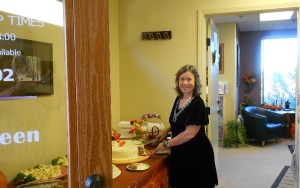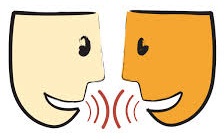The way we do simple, everyday things illuminates the different ways we process the world.
Tell me . . .
 The first time you walked into my office, what did you immediately notice first?
The first time you walked into my office, what did you immediately notice first?
- What I was doing? That is the kinesthetic channel.
- What I was talking about? That is the auditory channel.
- Looking around to see what was most interesting? That is the visual channel.
We need all three channels to learn effectively.
The difference is in what order we prefer to use them.
 Information is most easily retained when it follow the sequence of being received by the conscious mind, sorted by the subconscious mind, and integrated by the unconscious mind. What makes us different is the way each of the states of consciousness is linked to the channels of thought: visual, auditory, and kinesthetic.
Information is most easily retained when it follow the sequence of being received by the conscious mind, sorted by the subconscious mind, and integrated by the unconscious mind. What makes us different is the way each of the states of consciousness is linked to the channels of thought: visual, auditory, and kinesthetic.
There are six patterns of processing experience. They are reflected in our different ways of doing things. We usually have one pattern which is the most comfortable and effective way to learn something.
Dawna Markova, PhD wrote a book to change the way parents and schools allow children to process information for learning called How Your Child IS Smart – A Life-Changing Approach to Learning.
How DO we process information?
Dr. Markova’s model for information processing illuminates how we use our minds to think, learn and communicate. She says that the mind processes information by moving it through itself in different ways, sometimes called states of consciousness, each of which has its own particular function in learning. She is referring to the conscious, subconscious, and unconscious levels of the mind.
The conscious
 In the metaphor of the digestive system, the conscious state of mind is like the mouth. That is the doorway where learning begins. Information is taken in and chewed up, as the mind organizes how it will be further digested or processed. In the conscious mind, information is input, organized, prioritized, evaluated, and expressed most easily. In the conscious state of mind, people are alert, on the edge of their seats, with their attention turned to the outside world and what is being presented.
In the metaphor of the digestive system, the conscious state of mind is like the mouth. That is the doorway where learning begins. Information is taken in and chewed up, as the mind organizes how it will be further digested or processed. In the conscious mind, information is input, organized, prioritized, evaluated, and expressed most easily. In the conscious state of mind, people are alert, on the edge of their seats, with their attention turned to the outside world and what is being presented.
But in order to be fully nourished, the food cannot just stay in the mouth. It must go further as the mouth is just a small part of the entire digestive system. The stomach and intestines are further along and have completely different purposes, and so do further levels of the mind.
The subconscious
 The subconscious mind is like the stomach in that this is the place that things get churned around and mixed together. The food in the stomach is not the same as in the mouth, and yet it is not ready to be assimilated either. We do not swallow information whole.
The subconscious mind is like the stomach in that this is the place that things get churned around and mixed together. The food in the stomach is not the same as in the mouth, and yet it is not ready to be assimilated either. We do not swallow information whole.
At the subconscious stage of the learning process, we pause to consider incoming information, weighing it carefully, noticing how it fits with what has already been learned. Questions are debated, feelings wrestled with, and all viewpoints are considered. Being the intermediary, the subconscious mind will take what it is receiving from the conscious mind and move it to the memory banks of the unconscious mind. Reciprocally, what has been learned and stored in the unconscious mind can be pulled out and brought to the conscious mind so it can be used. The awareness is of both the input from the outside world and the inner frame of reference. This leaves us open to some confusion. In this sorting of information, our awareness moves from alertness of the conscious mind to deep relaxation, and from relaxation back to active self-expression.
The unconscious
 Then the processing moves to the unconscious level, like food moves into the intestines. By this time, the information has changed forms, it has been digested, in preparation for nourishing the whole body, feeding creativity. In the unconscious mind what is being learned is integrated with what is already known. Deep connections are made when memories are brought to mind. Experience is arranged and rearranged, making patterns of how things could be. These patterns can be experienced wholistically as symbols, imagery, analogy and dreams. Creative connections are made as thought circles and in this spaced-out state the whole is perceived.
Then the processing moves to the unconscious level, like food moves into the intestines. By this time, the information has changed forms, it has been digested, in preparation for nourishing the whole body, feeding creativity. In the unconscious mind what is being learned is integrated with what is already known. Deep connections are made when memories are brought to mind. Experience is arranged and rearranged, making patterns of how things could be. These patterns can be experienced wholistically as symbols, imagery, analogy and dreams. Creative connections are made as thought circles and in this spaced-out state the whole is perceived.
We are going through these conscious, subconscious and unconscious states instantly, triggered by sensory information all the time. Information moves inward when it is received and processed, leading to the outward movement of ideas created, expressed and transmitted.
Would you like to find out your style of learning?
These questions come from Dr. Markova’s book How Your Child IS Smart. In the following quiz, choose the one line that most represents you. Note the code at the end, and add up each V, K, and A letter for each position given – 1, 2, and 3. Then you may look at the synopsis of your pattern.
1. What do you remember most easily after seeing a movie, a TV program, or reading?
- What the people and the scenes looked like. V1
- What was said or how the music sounded. A1
- What happened or how the characters felt. K1
2. What’s the first thing you do to remember someone’s phone number?
- Say it to myself or hear it in my head. A1
- See the phone or the numbers in my head. V1
- Feel myself picking up the phone and dialing. K1
3. What’s the thing you remember most easily about people you just met?
- What you did with them or how they felt. K1
- How they looked. V1
- Their name or what they said. A1
4. What’s the scariest, hardest for you to take?
- Mean, hurtful words. A3
- Poking, invasive touch. K3
- Nasty looks. V3
5. How do you put something together?
- I read the directions and then do it. Telling me confuses me. K2A3
- I read the directions, ask questions, then talk to myself as I do it. A2K3
- I work with the pieces, then ask questions if I need to. I never read the directions. A2V3
- I work with the pieces, look at the diagram, then ask questions. A2V3
- I have someone tell me, then show me how, then I try it. V2A3
- I have someone tell me how to do it, then I try it. I only read directions as a last resort. K2V3
6. What’s most important when you decide which clothes to wear?
- How they feel, how comfortable they are, the texture. K1
- The colors, how they look on me, how thy go together. V1
- An idea of what’s me, the brand name, what the clothes say about me. A1
7. What is your biggest frustration?
- Feeling satisfied trying to make visions into reality. A1K2V3
- Putting feelings into words. Learning a physical skill without words or visuals to follow. A1V2K3
- Expressing feelings in words. K1V2A3
- Finding positive outlets for physical energy. K1A2V3
- Making time estimates. V1A2K3
- Thinking for myself. V1K2A3
If you printed this out, at this point, you may want to circle the letter in each position from your answers, to come up with your pattern.
1. V A K 2. V A K 3. V A K
The Six Patterns
AKV – The leaders of the pack
Easiest way to learn: hear / experience / see
Easiest way to express: say / do / show
Support them with an attentive ear, places to use their powerful energy, and encouragement to realize their many hopes and dreams
AVK – The verbal gymnasts
Easiest way to learn: Hear / See / Experience
Easiest way to express: Say / Show / Do
Support by encouraging them to discover the ideas and questions that will broaden their perspective and helping them give voice to all that is inside of them.
KAV – The Movers and Groovers
Easiest way to learn: Experience / Hear / See
Easiest way to express: Do / Say / Show
Support them by giving fun and practical outlets for their overflowing physical energy, as well as loving touch and attention while they tell you of their feelings, hopes, and dreams.
KVA – The Wandering Wonderers
Easiest way to learn: Experience / See / hear
Easiest way to express: Do / Show / Say
Support them by giving opportunities to actively explore their many interests, encouragement to find creative ways to express how they feel, and comfortable silence that will help them find their own voice.
VKA – The Seer / Feelers
Easiest way to learn: See / Experience / Hear
Easiest way to express: Show / Do / Say
Support them by the little things you do for them in which they see and feel love, your frequent touches, and little notes of encouragement which focus on what they have done well.
VAK – The Show and Tellers
Easiest way to learn: See / Hear / Experience
Easiest way to express: Show / Say / Do
Support them by giving them a place to shine brightly, a patient ear as they explore their feelings, and encouragement to go deeply enough to discover their sense of purpose and vision.
To Learn More . . .
There is much more detail about these learning styles in the book How Your Child IS Smart. Not only can it help you or your child learn and understand your unique needs but also single out behaviors that might stand in the way of learning.
 It is so valuable in interpersonal relationships, beyond the classroom learning relationship. From the processing patterns, you can understand where you get hung up communicating with a significant other or friend. It just might be that they want to know what you are feeling, and your feelings are in the unconscious, not easy to access. Or you might be telling someone over and over what you wish to communicate, but it would better get across if you showed them. Some people might need to write something down in order to process it later, while to another person that does not mean as much as having a recording to refer to later.
It is so valuable in interpersonal relationships, beyond the classroom learning relationship. From the processing patterns, you can understand where you get hung up communicating with a significant other or friend. It just might be that they want to know what you are feeling, and your feelings are in the unconscious, not easy to access. Or you might be telling someone over and over what you wish to communicate, but it would better get across if you showed them. Some people might need to write something down in order to process it later, while to another person that does not mean as much as having a recording to refer to later.
Go ahead and leave your comments below about your insights and experiences when you understand the ways of processing information and learning.





